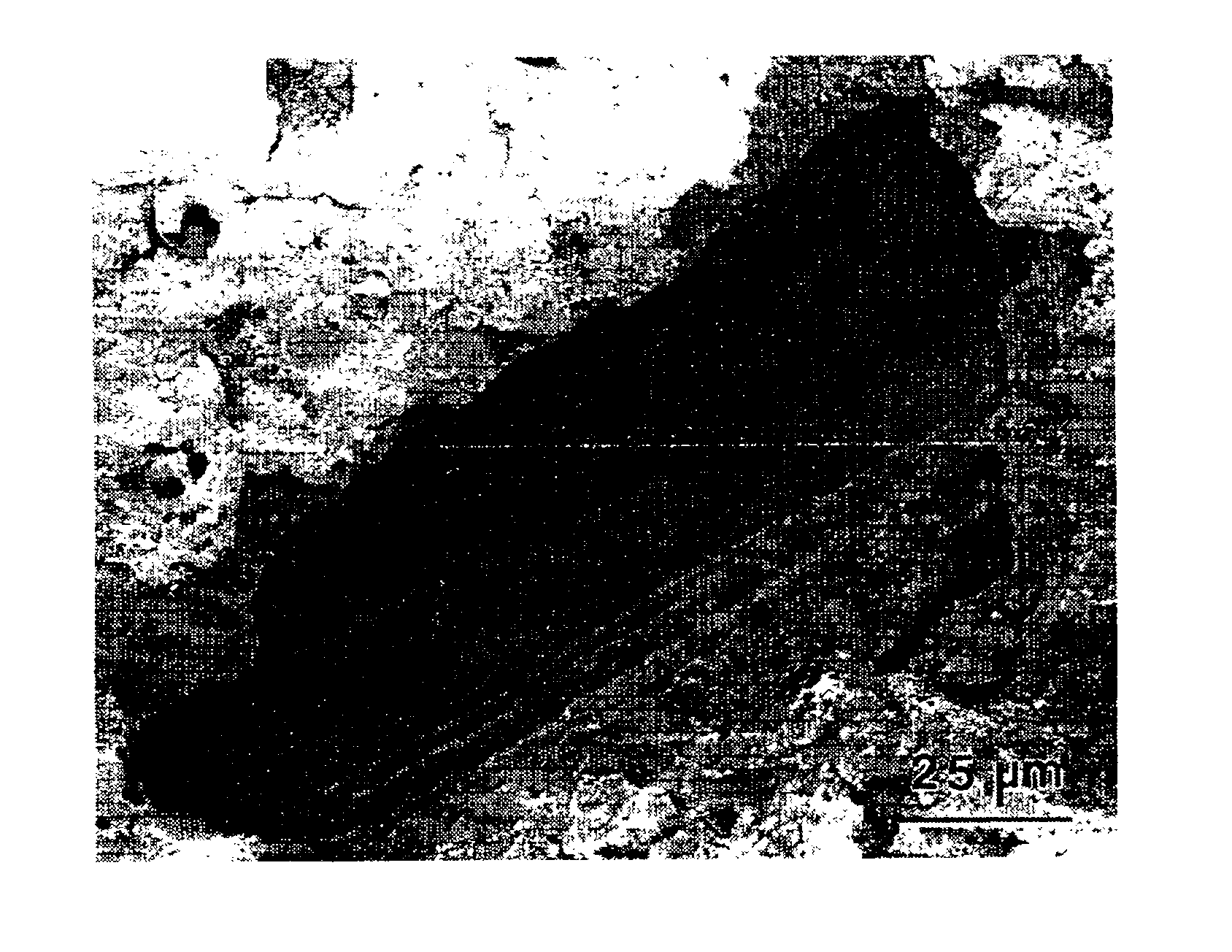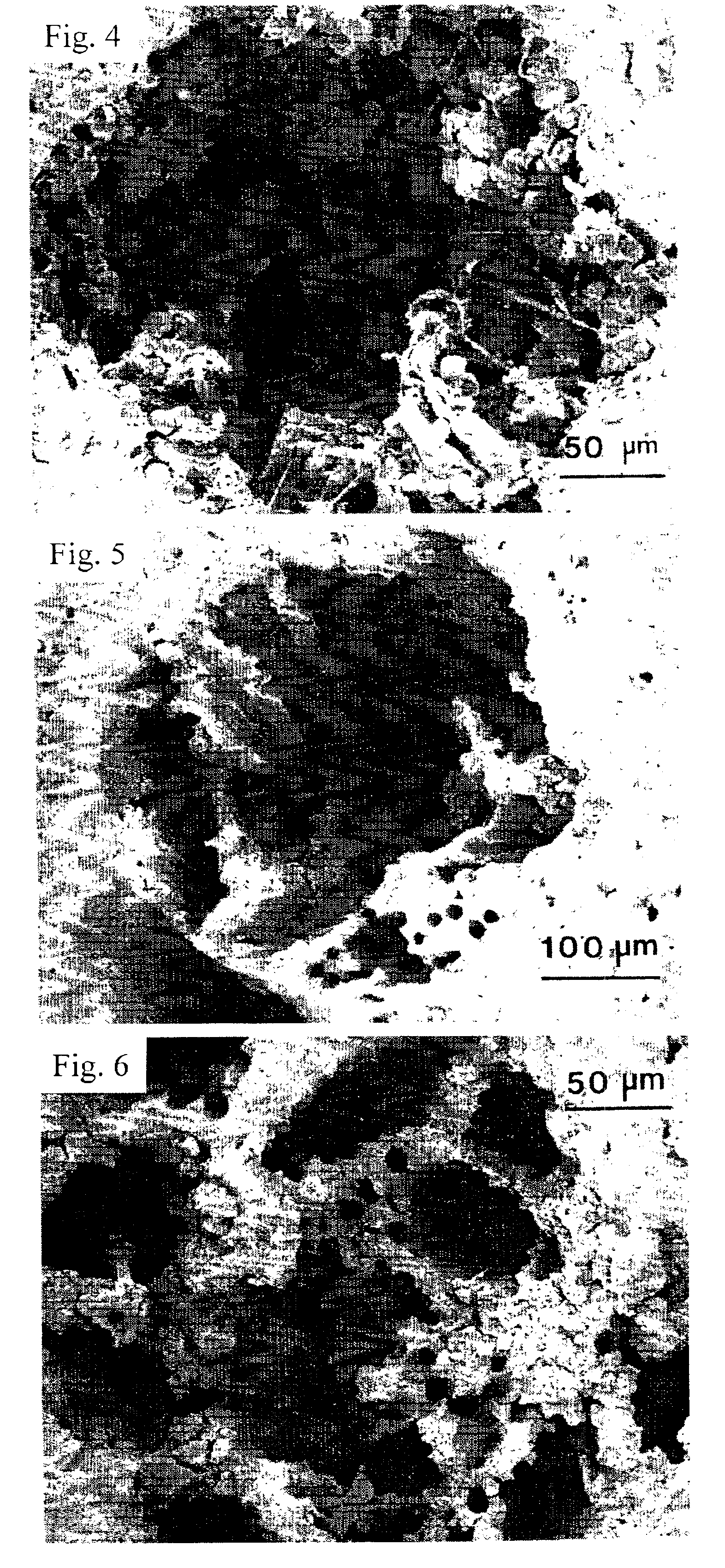Self-hardening calcium phosphate materials with high resistance to fracture, controlled strength histories and tailored macropore formation rates
a calcium phosphate material and self-hardening technology, applied in the field of bone substitute replacement materials, can solve the problems of limited use of cpc, mechanical weakness and limited application of self-hardening calcium phosphate materials
- Summary
- Abstract
- Description
- Claims
- Application Information
AI Technical Summary
Benefits of technology
Problems solved by technology
Method used
Image
Examples
example 1
Fabrication
[0035]An example of use of this invention is dental, craniofacial and orthopedic bone repair. A calcium phosphate powder is randomly mixed with soluble fillers and pore forming agents such as mannitol crystals (CH2OH[CHOH]4CH2OH). The mixture is then mixed with a liquid (water) into a paste. The mannitol crystals can quickly dissolve to produce macropores for vascular and bone ingrowth. Also mixed into the paste are absorbable fibers (for example, Vicryl suture, polyglactin 910 (copolymer of glycolide and lactide) Ethicon, Somerville, N.J.) to provide substantial strengthening and toughening while tissue is growing into the initial macropores resulting from mannitol crystal dissolution. The absorbable fibers themselves can then dissolve and create additional macropores for further ingrowth. Also mixed into the paste are absorbable fibers with a slow rate of dissolution (for example, Panacryl™ suture (copolymer of lactide and glycolide), Ethicon, NJ) so that they can provi...
example 2
Fabrication
[0036]Another example of manufacture comprises bone graft materials with multiple layers. Layered implants can be functionally-graded, by providing tailored layers with graded functions, or by using a single layer with a controlled gradient or variation in functions within the layer. For example, for an implant with several layers, the external layer may contain fillers or fibers with fast dissolution rates to provide a high initial strength and then quickly create macropores to accept vascular ingrowth. The second layer contains fillers or fibers with slow dissolution rates for strength, and then dissolve to form macropores after bone growth into the first layer. Bone ingrowth increases the implant strength, which would offset the strength decrease from fiber degradation. The third layer contains fillers or fibers with slower dissolution rates, or even stable fibers, for longer-term reinforcement for the implant. By the time the fillers or fibers with slow dissolution di...
example 3
Fabrication
[0037]As another example of manufacture of the invention, functionally-graded bone graft materials containing layered structures are prepared with either flat layers or curved layers. An example of curved layers would be a cylindrical implant, having an external surface layer reinforced with fast-dissolution fillers or fibers for macropores to accept vascular ingrowth. The second layer of the cylindrical implant contain fillers or fibers with medium-dissolution rates for short-term strength, which then dissolve to form macropores after bone growth into the first or external surface layer. The strong core of the cylindrical implant contains slow-dissolution fillers or fibers, or even stable fibers, or a strong fabricated insert such as a titanium pin or a ceramic rod, for longer-term reinforcement. Other functionally-graded graft materials and implants containing flat or curved layers with less than or more than two or three layers can be similarly produced to have control...
PUM
| Property | Measurement | Unit |
|---|---|---|
| time | aaaaa | aaaaa |
| time period | aaaaa | aaaaa |
| time period | aaaaa | aaaaa |
Abstract
Description
Claims
Application Information
 Login to View More
Login to View More - R&D
- Intellectual Property
- Life Sciences
- Materials
- Tech Scout
- Unparalleled Data Quality
- Higher Quality Content
- 60% Fewer Hallucinations
Browse by: Latest US Patents, China's latest patents, Technical Efficacy Thesaurus, Application Domain, Technology Topic, Popular Technical Reports.
© 2025 PatSnap. All rights reserved.Legal|Privacy policy|Modern Slavery Act Transparency Statement|Sitemap|About US| Contact US: help@patsnap.com



